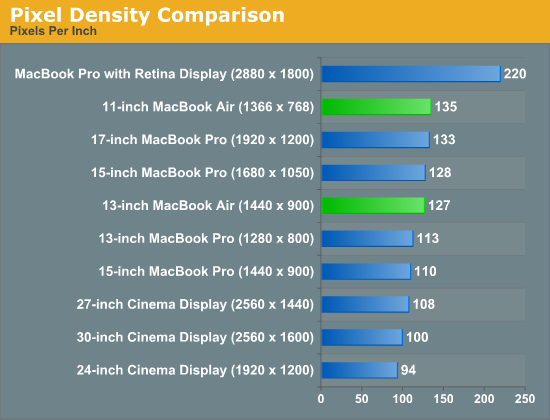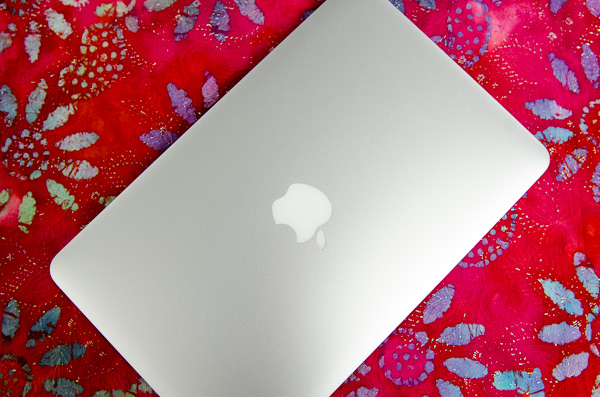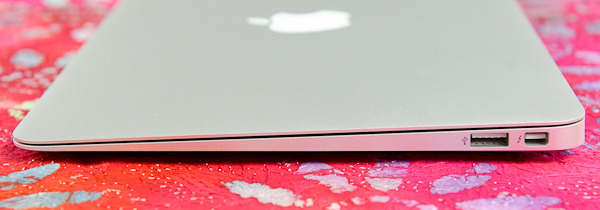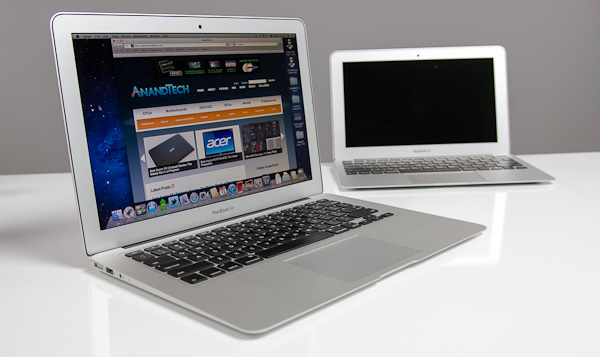The 2012 MacBook Air (11 & 13-inch) Review
by Anand Lal Shimpi on July 16, 2012 12:53 PM EST- Posted in
- Apple
- Mac
- MacBook Air
- Laptops
- Notebooks
Things are getting very blurry.
The MacBook Pro once stood for tons of power plus upgradability. Add a Retina Display and now it's just tons of power. It's a thicker, faster MacBook Air (with an awesome display). It's not bad, in fact it's quite amazing, but it confuses the general order of things.
The MacBook Air doesn't help in the clarity department. You can now order a MacBook Air with up to 8GB of RAM and a 512GB SSD, for the first time in MacBook Air history. Users who were once forced into Pro territory because of RAM and storage requirements can now happily live with an Air. And thanks to Turbo Boost, you do get similar performance in lightly threaded workloads.
Take a step away from the Mac world and you'll see the rest of the market is going through its own confusing period. Nearly every single Microsoft partner is mixing tablets and Ultrabooks. If your tablet uses smartphone hardware, and can dock into a notebook or Thunderbolt itself into a desktop, is all of this a lot of confusion before client computing moves entirely to smartphones? NVIDIA said it would happen publicly (even Intel did so privately a few years ago). Maybe it wasn't just convenient rhetoric. Maybe that's where we're headed. Until then, there are going to be a lot of different form factors, all with very compelling features. The MacBook Air continues to be one of them.
Despite the recent Ultrabook frenzy, the MacBook Air was one of the first (if not the first) to marry performance with usability, screen size/resolution, portability and battery life. Ultraportables prior to the MacBook Air's arrival in 2008 typically sacrificed in one or more of the above areas. I spent years in pursuit of the perfect ultraportable in college over a decade ago (30 is the new 20 right?), and generally came away disappointed and empty handed.
In 2010 Apple changed the expectations of cost with the MacBook Air. The new 11-inch model would start at just $999. And the 13-inch would only cost $300 more. The very first MacBook Air, by comparison, retailed for $1800. Apple took an ultraportable and made it its mainstream notebook. It was a bold move but one that was very forward looking.
Today the MacBook Air is even more affordable. The 11-inch model still starts at $999, but the 13-inch version is only $200 more. From the outside not a lot has changed, but that doesn't mean there's any less to talk about. Ivy Bridge, USB 3.0 and faster SSDs are all on the menu this year. Let's get to it.
The 11 & 13
Unlike the other thin member of Apple's Mac lineup, the MacBook Air chassis hasn't changed over the past three years. Since the 2010 update that gave us the 11-inch model and significantly lower prices, Apple has stuck with a design that only recently has seen widespread emulation.
While our last review focused on the beginning of a new generation, this review takes a look at a very mature, yet still very good design. The MacBook Air is just so pleasant to carry around. It'll make even the new rMBP feel like a pig.
Both the 11 and 13-inch models are effortless to carry around. While I dread traveling with a traditional notebook, slipping one of these into my backpack is barely noticeable. You can get used to and take for granted just about anything, but the form factor of the MacBook Air continues to be a favorite of mine even today.

The 11-inch MacBook Air is a great option for those who want the portability of a tablet but find themselves wanting to attach a keyboard to it most of the time. The 11.6-inch display boasts the highest pixel density of all of Apple's non-retina displays at 1366 x 768, but it's still quite usable. You don't make any sacrifices on keyboard size or key spacing (it's identical to the 13-inch model for the majority of the keys), nor do you have to give up any performance either. Apple offers all of the same CPU, memory and storage upgrades across both MacBook Airs. And with no discrete GPU, thermal throttling isn't really a problem either in the 11-inch chassis. With Thunderbolt, the 11-inch MacBook Air can actually give you the best of both worlds: an incredibly portable computer when you're on the go, and enough to act as your desktop when docked to a Thunderbolt Display.
I've traditionally always bought the 11-inch MacBook Air with the thought that I'd carry it when I didn't need to lug around my MacBook Pro. I seemed to be fooling myself however as over 90% of the time I'd end up with the MacBook Pro. The 11-inch Air was relegated to typewriter duty when I needed a change of scenery while writing at home. It's a great writer's companion, but if I couldn't have more than one system I'd have to opt for its bigger brother.
When I first reviewed the redesigned 13-inch MacBook Air I wrote that it felt more like a normal notebook, while the 11 was something a bit more unique. Perhaps I was more infatuated with the new 11 at the time, because these days I'm more drawn to the 13-inch MacBook Air as the notebook to have if you can only have one.
You get a 23.5% increase in screen resolution on a display that's just easier to look at. While 1440 x 900 is a bit much on a 15-inch MacBook Pro, I'd say it's near perfect on the 13-inch Air. If Apple were to do the Retina treatment on here, it'd be magnificent.
The larger chassis allows room for an SD card reader, which is thankfully quite functional. Otherwise the port layout is identical to the 11-inch model.
| 2012 MacBook Air Lineup | ||||||
| 11.6-inch | 11.6-inch (high-end) | 13.3-inch | 13.3-inch (high-end) | |||
| Dimensions |
H: 0.11-0.68" (0.3-1.7cm) W: 11.8" (30cm) D: 7.56" (19.2cm) |
H: 0.11-0.68" (0.3-1.7cm) W: 12.8" (32.5cm) D: 8.94" (22.7cm) |
||||
| Weight | 2.38 lbs (1.08kg) | 2.96 lbs (1.35kg) | ||||
| Cores/Threads | 1.7GHz dual-core Core i5 | 1.8GHz dual-core Core i5 | ||||
| Base Clock Speed | Intel HD 4000 | |||||
| RAM | 4GB DDR3L-1600 | |||||
| SSD | 64GB SSD | 128GB SSD | 128GB SSD | 256GB SSD | ||
| Display Resolution | 1366 x 768 | 1440 x 900 | ||||
| Ports | Thunderbolt, 2x USB 3.0, headphone jack | Thunderbolt, 2x USB 3.0, SD card slot, headphone jack | ||||
| Price | $999 | $1099 | $1199 | $1499 | ||
In its role as a proponent of simplicity, Apple has reduced the decision between what Air to get down to screen size, resolution and battery life (the 13-inch chassis houses a much larger battery). If you like having more of all of those things, the 13-inch Air is for you. If carrying anything larger than a tablet upsets you, buy the 11.




















190 Comments
View All Comments
robco - Wednesday, July 18, 2012 - link
I have a few friends who upgraded to the new Airs and love them. I'm holding onto my 3 year old MBP for another year until Haswell comes out. Though it looks like the HD 4000 can keep up with or even surpass the 9600M in mine.I'm leaning toward the Air, though my personal prediction (hope?) is that when Haswell comes out next year, that will have enough oomph for Apple to launch the 13" rMBP with a 2560x1600 display. If they can keep the weight under 4 lbs., that would be awesome.
As for Apple not being the first, being first isn't always best. There were other ultraportables before the 2010 Air, but few sold in large volume. There were tablets before the iPad, but relatively few sales. There were smartphones before the iPhone, but few consumers wanted them. Being first isn't important, executing a good product is.
And for the anecdotal stories, how a company handles a problem is also quite important. I'm on my second Apple laptop, but each one has had issues (I get AppleCare). On my 2006 MB, the trim started pulling away, made an appointment at the Apple Store, they replaced the top case the same day. A week before AppleCare expired, I noticed the optical drive had failed (never really used it), they not only replaced it, but found that one of the cooling fans wasn't operating quite as fast as it should, they replaced that too. When I got my 2009 MBP, the trackpad started sticking and wouldn't click, fixed same day. I got a battery error, that was replaced in about 20 mins. No waiting on hold for hours, going through a bunch of repetitive nonsense. Fixed quickly, no questions asked. I don't expect to never have an issue, I'm hardly gentle with my laptops, but when something does happen, it's nice to know things get fixed quickly without a lot of hassle. Then again, that's just my own personal experience...
MobiusStrip - Wednesday, July 18, 2012 - link
Yay, more Apple computers with mandatory, shitty glossy screens.What kind of "leader" takes its cues from the third-tier plastic schlock being peddled at Best Buy? Glossy screens are the biggest regression in computing ever. Absolutely moronic.
Deepcover96 - Wednesday, July 18, 2012 - link
I hadn't noticed that my 2012 MacBook Air's screen was glossy. Maybe they made it less glossy?phillyry - Tuesday, March 26, 2013 - link
Maybe they made them extra glossy on purpose so that we wouldn't be able to notice the terrible viewing angles for all the glare!phillyry - Thursday, March 28, 2013 - link
Also helps to hide the pixelation.Lepton87 - Wednesday, July 18, 2012 - link
I have something to say regarding anand's conclusion that 1920x1200 on a 11' is a stopgap solution and apple is too great to settle for something so mediocre. 2732x1536 on the 11.6 is totally idiotic. You don't need more than 120PPI on a desktop and 140PPI on a laptop for a screen to be considered retina.(remember viewing distance is a big factor) So why waste all that processing power? Even retina Macbook pro can't render everything silky smooth. Even my 2560x1440 desktop 27'' "lowly" resolution screen is 90% retina, taking into account my less than perfect eyesight into equation it's probably very close all that I need to not seen individual pixels from normal viewing distance. 2880x1800 on 27' would make it a perfect screen for my, everthing more than that would choke my already outdated quadfire 2x6990 CF set-up. The boss probably won't honor me with answering this personally :( I would really like to know his view on increasing resolution way past what would be considered retina, i.e making pixels much smaller than the necessary size for them to be not discernible individually from normal viewing distance.Znarkus - Thursday, July 19, 2012 - link
It would've been awesome to compare max power draw and surface temperature with the different CPUs, especially the i7 :)Alameda - Saturday, July 21, 2012 - link
I have a 2011 MacBook Air. I think the big improvement in 2012 is USB 3. Time Machine backups take a very long time (I backup once every few days). USB 3 would clearly make a big difference here. Thunderbolt, sadly, is too expensive to justify, unless you're backing up to a RAID or some such.Galatian - Sunday, July 22, 2012 - link
Hey Anand,I have yet to get back to you again concerning the Gaming Performance on the i5 ULV with HD4000. I was coming from a 2008 Unibody MacBook Pro (2,53 GHz, 8 GB RAM, Vertex 2, nVidia 9600M 512 MB vRAM), so I naturally expected that Civilization V would not run as fast on my new MacBook Air under Windows than it did on my old MacBook Pro. At least your charts suggest so. According to FRAPS I would get around 22 fps, which is not stellar but enough for turn based strategy game.
I don't know if there has been any update on the driver or what, but Civilization V is actually more playable on my MacBook Air then on my old MacBook Pro. The CPU of course is faster. My MacBook Pro would overheat and hence the Core 2 Duo only ran with like 2,0 GHz while playing the game, while the Ivy Bridge ULV actually still has enough headroom to Turbo Boost. The big surprise to me was actually the graphic performance, which has been much smoother. For the sake of it I would really like to know how you get your extremely low fps while testing Civilization V? Are you running the newest version w/o Gods & Kings add-on? Do other persons have the same experience? I thought I would make a step back in gaming performance when I switched to the MacBook Air, but to my surprise this isn't the case. I sure would like other people to know this, so they can put the Ivy Bridge ULV in better perspective.
Along the line I would really like to see a comparison between AMDs and Intels ULV offerings. The tests I see only only compare the A10 (which has a much higher TDP) to Intels ULV platform. From my understanding only the Bobcat should be comparable to Intels ULV offering. Then again I really can't follow what is what with AMD especially I don't which ones are released and which ones are not...
cookiezulu - Monday, July 30, 2012 - link
Hi Anand, thank you for yet another excellent review! I was worried for a sec there that you might be busy with other things and skip the review for the MBA this year.The MBA 2012 (8GB, stock processor) is my first ever MAC and also my first computer with an SSD drive. I'm not very familiar with how the SD Card slots work in these SSD machines and/or in Mac machines and I would like to buy one of these:
http://www.kickstarter.com/projects/1342319572/the...
It's essential a microSD card holder that sits flush with the MBA (rather than sticking out). I held out because of the issue of the SD card preventing the computer from going into deep sleep mode, as per Apple support article here:
https://support.apple.com/kb/HT4392
Somebody then thought to ask what happens if the SD/microSD card is left in place but it is unmounted on a software level. In theory this should allow the Macs to go into deep sleep (standby) mode as the SD card slot would be just as 'dead' as if the card wasn't there.
I'm definitely looking to always have an SD card into the slot, both to increase storage but also, and more importantly, to use it for exactly the types of activities that you mention in the article as slowing it down. I want the SSD to run just operating system and installed programs. All others (downloads, music, photo, etc) I want to keep on external devices.
Can you, by any chance, offer any help/info/clarification on this one?
Thanks ever so much